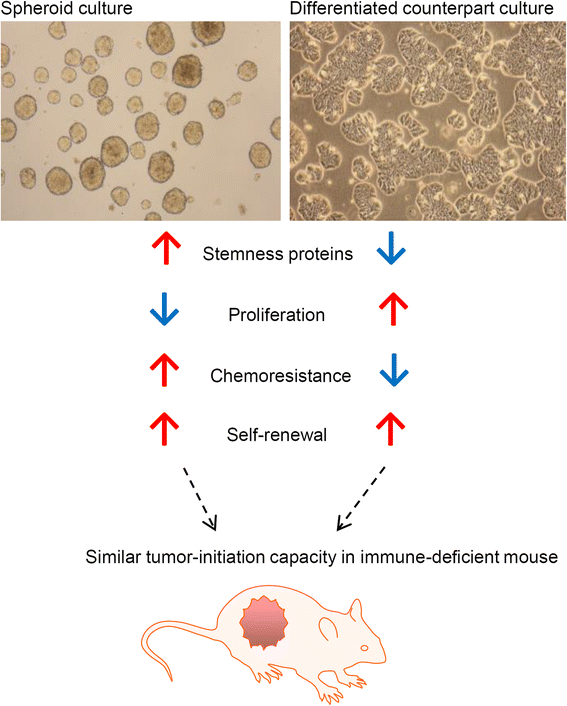Tumor-Initiating Cells: a criTICal review of isolation approaches and new challenges in targeting strategies
- PMID: 28209178
- PMCID: PMC5314476
- DOI: 10.1186/s12943-017-0602-2
Tumor-Initiating Cells: a criTICal review of isolation approaches and new challenges in targeting strategies
Abstract
Most cancers contain a subpopulation of highly tumorigenic cells, known as cancer stem cells (CSCs) or tumor-initiating cells (TICs). Targeting TICs may be essential to achieve cure, because of their self-renewal and tumorigenic properties as well as their resistance to conventional therapies. Despite significant advances in TIC biology, their isolation and identification remain largely disputed and incompletely established. In this review, we discuss the latest developments in isolation and culturing approaches of TICs, with focus on colorectal cancer (CRC). We feature recent findings on TIC-relevant signaling pathways and the metabolic identity of TICs, as well as their current clinical implications. Lastly, we highlight the influence of inter- and intra-tumoral heterogeneity on TIC function and targeting approaches.
Keywords: Cancer stem cells; Colorectal cancer; Culturing conditions; Inter- and intra-tumor heterogeneity; Metabolic identity; Spheroid Culture Systems; Surface markers; Targeted therapy; Tumor-initiating cells.
Figures

Similar articles
-
[Research progression in colorectal cancer stem cells].Zhonghua Wei Chang Wai Ke Za Zhi. 2013 Mar;16(3):297-300. Zhonghua Wei Chang Wai Ke Za Zhi. 2013. PMID: 23536355 Review. Chinese.
-
Establishment of highly tumorigenic human colorectal cancer cell line (CR4) with properties of putative cancer stem cells.PLoS One. 2014 Jun 12;9(6):e99091. doi: 10.1371/journal.pone.0099091. eCollection 2014. PLoS One. 2014. PMID: 24921652 Free PMC article.
-
Hypoxia-induced autophagy drives colorectal cancer initiation and progression by activating the PRKC/PKC-EZR (ezrin) pathway.Autophagy. 2020 Aug;16(8):1436-1452. doi: 10.1080/15548627.2019.1687213. Epub 2019 Nov 27. Autophagy. 2020. PMID: 31775562 Free PMC article.
-
Isolation, identification, and characterization of cancer stem cells: A review.J Cell Physiol. 2017 Aug;232(8):2008-2018. doi: 10.1002/jcp.25759. Epub 2017 Feb 28. J Cell Physiol. 2017. PMID: 28019667 Review.
-
Targeting cancer stem-like cells in glioblastoma and colorectal cancer through metabolic pathways.Int J Cancer. 2017 Jan 1;140(1):10-22. doi: 10.1002/ijc.30259. Epub 2016 Jul 20. Int J Cancer. 2017. PMID: 27389307 Review.
Cited by
-
p63: a crucial player in epithelial stemness regulation.Oncogene. 2023 Nov;42(46):3371-3384. doi: 10.1038/s41388-023-02859-4. Epub 2023 Oct 17. Oncogene. 2023. PMID: 37848625 Free PMC article. Review.
-
Subsets of cancer cells expressing CX3CR1 are endowed with metastasis-initiating properties and resistance to chemotherapy.Oncogene. 2022 Feb;41(9):1337-1351. doi: 10.1038/s41388-021-02174-w. Epub 2022 Jan 8. Oncogene. 2022. PMID: 34999735 Free PMC article.
-
Synergistic effects of abietic acid combined with doxorubicin on apoptosis induction in a human colorectal cancer cell line.Sci Rep. 2025 May 8;15(1):16102. doi: 10.1038/s41598-025-99616-2. Sci Rep. 2025. PMID: 40341222 Free PMC article.
-
Isolation of cancer cells with augmented spheroid-forming capability using a novel tool equipped with removable filter.Oncotarget. 2018 Sep 21;9(74):33931-33946. doi: 10.18632/oncotarget.26092. eCollection 2018 Sep 21. Oncotarget. 2018. PMID: 30338036 Free PMC article.
-
Role of nitric oxide in pancreatic cancer cells exhibiting the invasive phenotype.Redox Biol. 2019 Apr;22:101158. doi: 10.1016/j.redox.2019.101158. Epub 2019 Mar 6. Redox Biol. 2019. PMID: 30852389 Free PMC article.
References
Publication types
MeSH terms
Substances
LinkOut - more resources
Full Text Sources
Other Literature Sources
Medical

